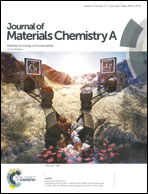CoOx–carbon nanotubes hybrids integrated on carbon cloth as a new generation of 3D porous hydrogen evolution promoters†
Abstract
Water splitting is the mainstay of contemporary energy conversion and storage engineering. The design of earth-abundant electrode materials without extra binders for an efficient hydrogen evolution reaction (HER) is critical in realizing the hydrogen economy in the push for future sustainable development. Herein, three-dimensional (3D) porous electrodes (denoted CoOx–CNT–CC) featuring CoOx nanoparticles (NPs) and carbon nanotubes (CNT) growing on activated carbon fiber were synthesized through a one-pot pyrolysis process. The achieved 3D electrodes acted as efficient electrocatalysts as well as current collectors for hydrogen production, greatly simplifying the electrode preparation process. Impressively, the electrodes exhibited high current density under low overpotential. The current density can reach up to ∼720 mA cm−2, an overpotential of ∼99 mV is required to reach a current density of 20 mA cm−2, and they function with a durability of up to 70 h. Beyond that, the electrodes still show superb catalytic properties at low temperature (the current density is 326 mA cm−2 even at 278 K) and in a neutral medium (the current density is 450 mA cm−2 in 1 M PBS).



 Please wait while we load your content...
Please wait while we load your content...